
Blue | White

This is part four of my five-part series on Morocco. I have provided links (in purple) whenever possible; several places do not have websites, but they often have Wikipedia pages. Please be sure to read the notes at the end of this post as you consider traveling to this beautiful country.
“The Blue Pearl” — Chefchaouen — lies about three and one-half hours north of Fès in the Rif (REEF) Mountains. Called simply Chaouen by its Berber founders, it is a beautiful city on the side of a mountain, sparking blue for all to see. There was no European presence until the Spanish occupied northern Spain in the early twentieth century. The town’s blue moniker has been around for almost a century, perhaps much longer, but its blueness has really taken off since the advent of social media.
Ryad Lina
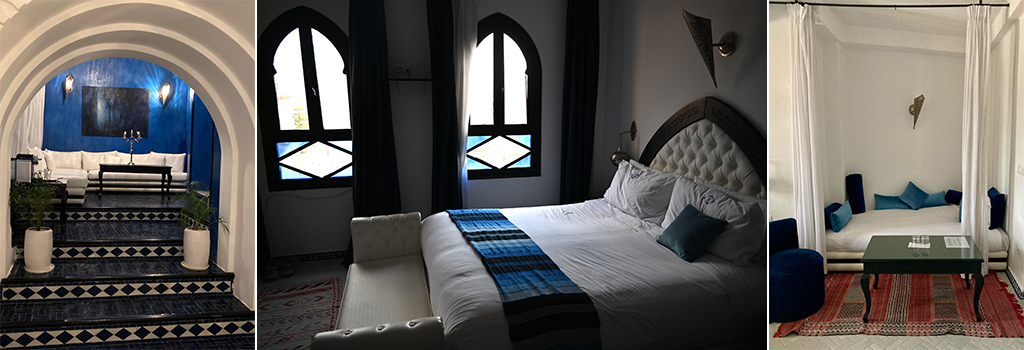
We stayed right in the middle of the medina — at Ryad Lina. Neither the town nor hotel is handicapped accessible; the streets are full of steep slopes and steps, and at the hotel guests must climb two flights of stone stairs to the entry. Once inside, more wonky stairs await. It is a lovely hotel, with a small indoor dining area, warm reception, and — as with many places — a roof top terrace. One note: alcohol is not served in the hotel, nor in most of the city. Our room had a queen-size bed and an alcove bed — why is an alcove bed so alluring and romantic? The room was very spacious, and the bathroom was large and the shower as big as our entire bathroom here at home.
Walking the City
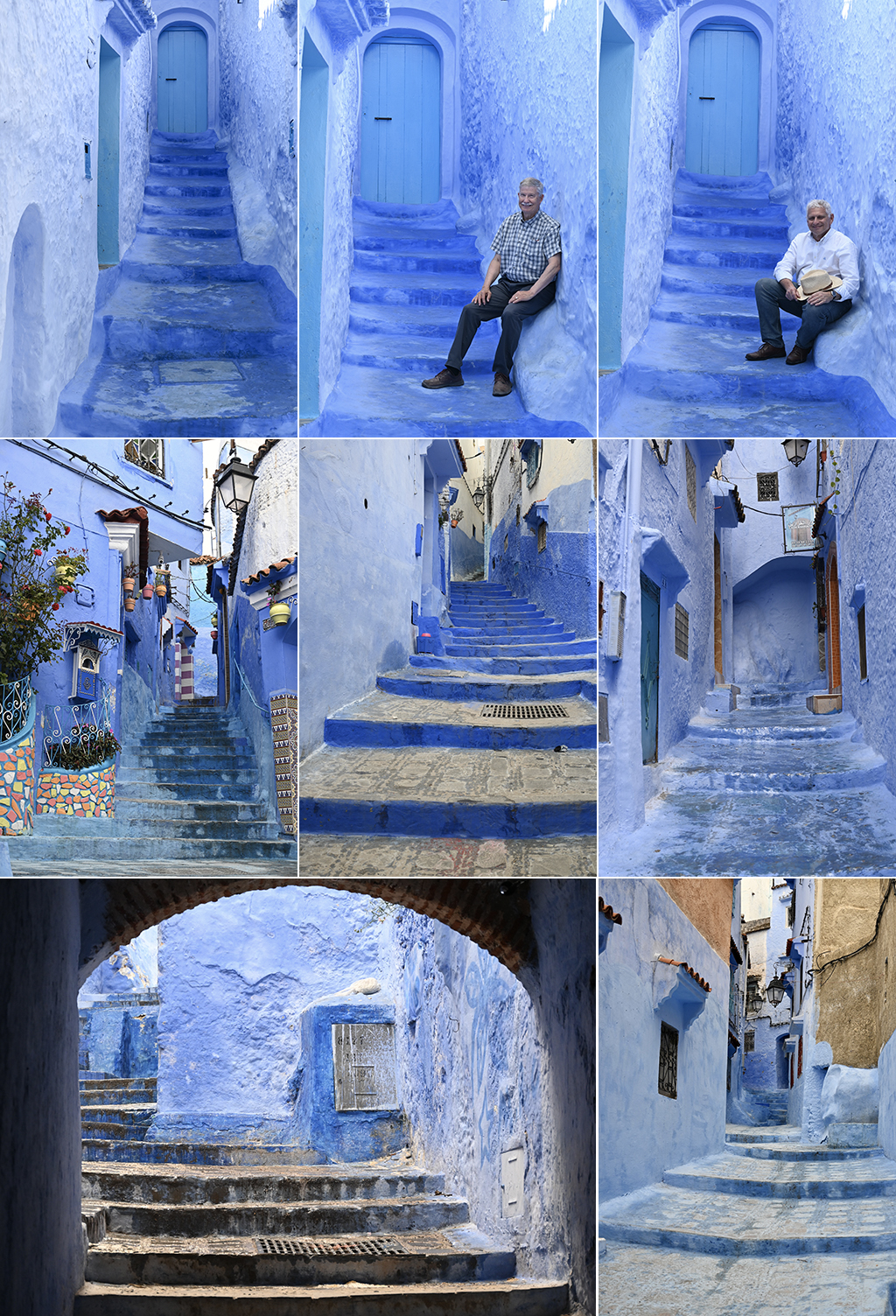
Our guide, Mohammed, shared with us a variety of stories as to why the city is blue: a touch of indigo was added to the white paint to ease the eyes in the strong sunlight; or blue was a preferred taste of Jews who sought refuge there from the Spanish Inquisition; a shopkeeper used a bluer blue around his shop, got more business, and was soon mimicked by others; and, most recently, in the early 2010s, an Instagrammer posted a photo of a blue staircase, which encouraged more curiosity seekers, and the rest is history. Our guide even told us that blue is now required on the lower stories in the Medina, though I have not been able to document that. Whatever the story, the small mountain city is beautiful.

Today, I’m adding to the social media trend. I’m going to tag Chefchaouen and (I hope) many more people will see it. There is a problem with the city’s somewhat recent notoriety, but it is a good/bad problem. It is bad because this once sleepy and untouched city is now busy with tourists (ahem, guilty as charged) seeking “the” blue staircase, or any other number of Instagrammable spaces. Admit it; selfie instagrammers are not always the most culturally alert or sensitive tourists; most are fine, but the worst of them have established a worldwide record of disrespecting and trammeling rare cultural monuments.
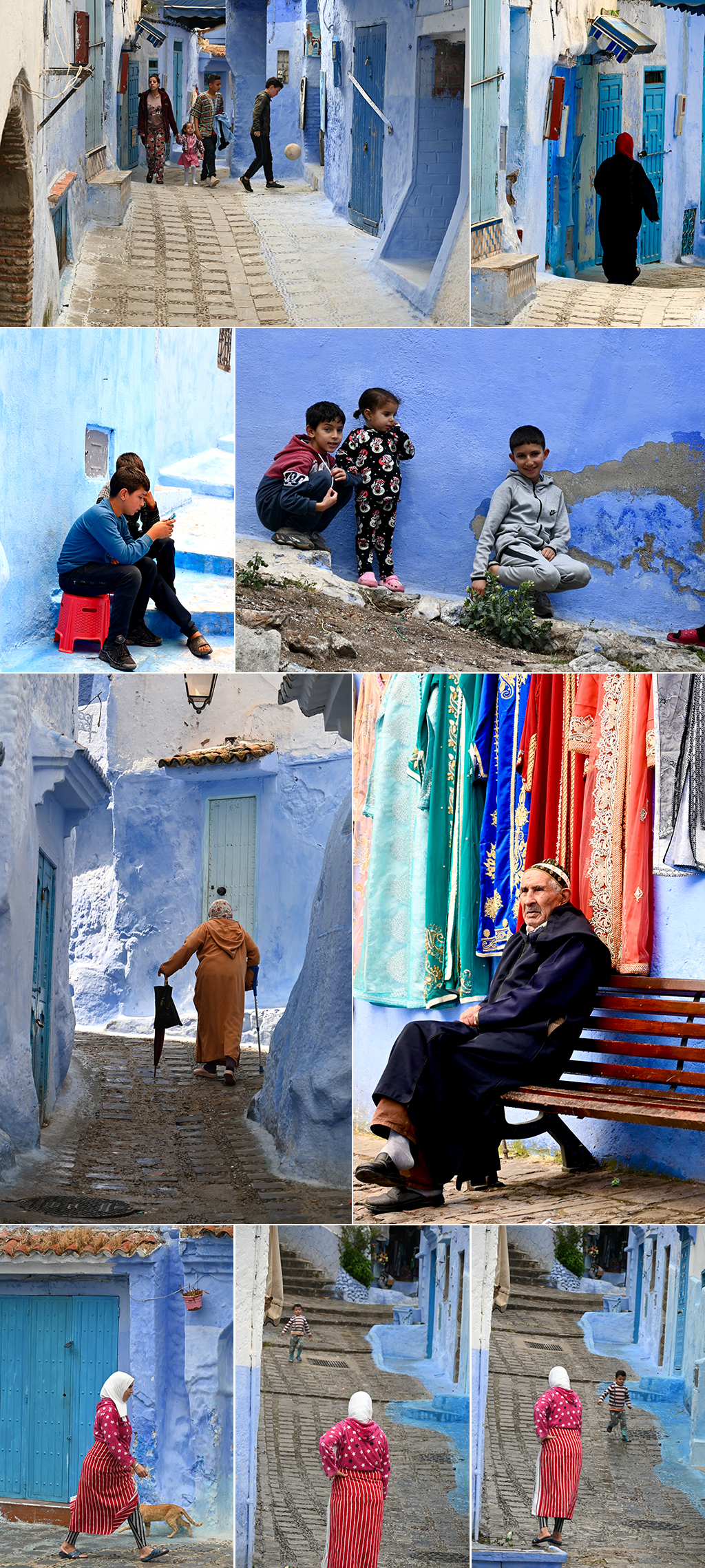
But, for those who live there, this increase in tourism has been a very good economic engine. The city is lively with new shops, restaurants, coffee kiosks. Young locals need no longer leave their home to find employment and a future. Its newfound popularity is a good/bad problem. Its is a great place to watch children playing in the streets, people taking advantage of benches to rest as they climb the hills, mothers calling for their children to come in for lunch.

As for what to do in Chefchaouen? Walk. Seriously, I could walk around for hours just marveling at all the different hues of blue… periwinkle, cobalt, sky, indigo, turquoise, cerulean, azure. There are a very few historic monuments (the Kasbah, the Spanish Mosque, an ethnographic museum), and one can walk in a few minutes to the far west end of the old town to where the springs come out of the Rif Mountains into the city. It is also where the Lavadero de Ciudad – the community laundry – is located; you can see women washing there laundry there, even on a rainy day. Something fun to note (and you can see it in several photos): main streets in Chefchaouen have a clearly delineated line of cobbles down the middle of the street. Secondary streets will have two lines of cobbles – one on each side. Dead end streets will have a line of cobbles at the base of the street. It is a fascinating way not to get lost! The best photo to see this is below – the image with our guide Mohammed and Lisa.
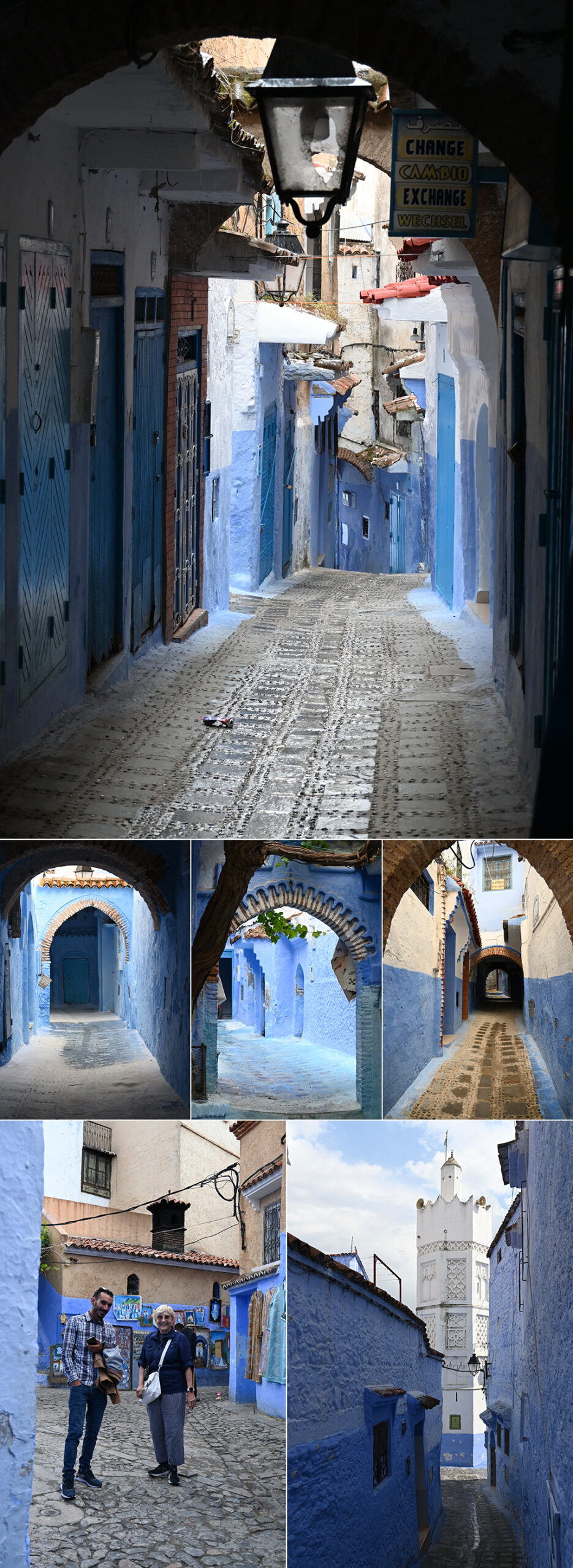
As always, doors fascinate me. Door hardware, cart gates, hobbit doors, rooftop doors. We hear nighttime in the main square — Place Outa el Hamam — is fun and lively, but it was drizzling the night we were there and it was pretty empty. Tant pis. It’s still fun to walk with a nice view of the Mosque and any number of restaurants from which to choose.
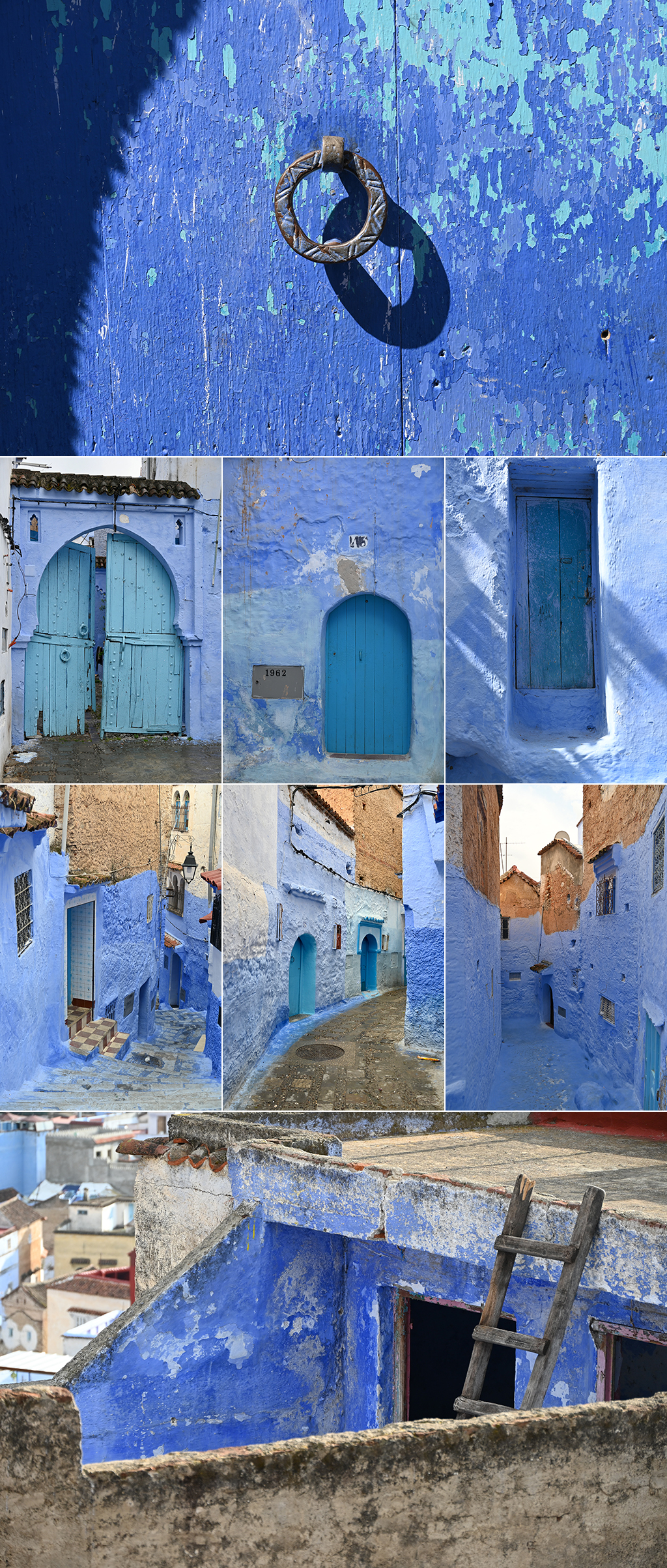
Dinner Out

As we didn’t reserve in advance with the hotel for an in-house dinner, we went out for a night on the town. We dined at Restaurant Casa Hassan (Rue Esstitou el Hadri, 90080 Chefchaouen) — a small riad with a tall central courtyard and fun décor. The waiters were wearing clothes of a style we hadn’t seen before — white shirts with colored band collars, and fully-pleated baggy white trousers. A defunct local tradition or comfortable looking uniform? We don’t know. We both dined on harira and grilled swordfish with sautéed vegetables. The harira was very good and it was nice to have simply prepared fish.
Tétouan
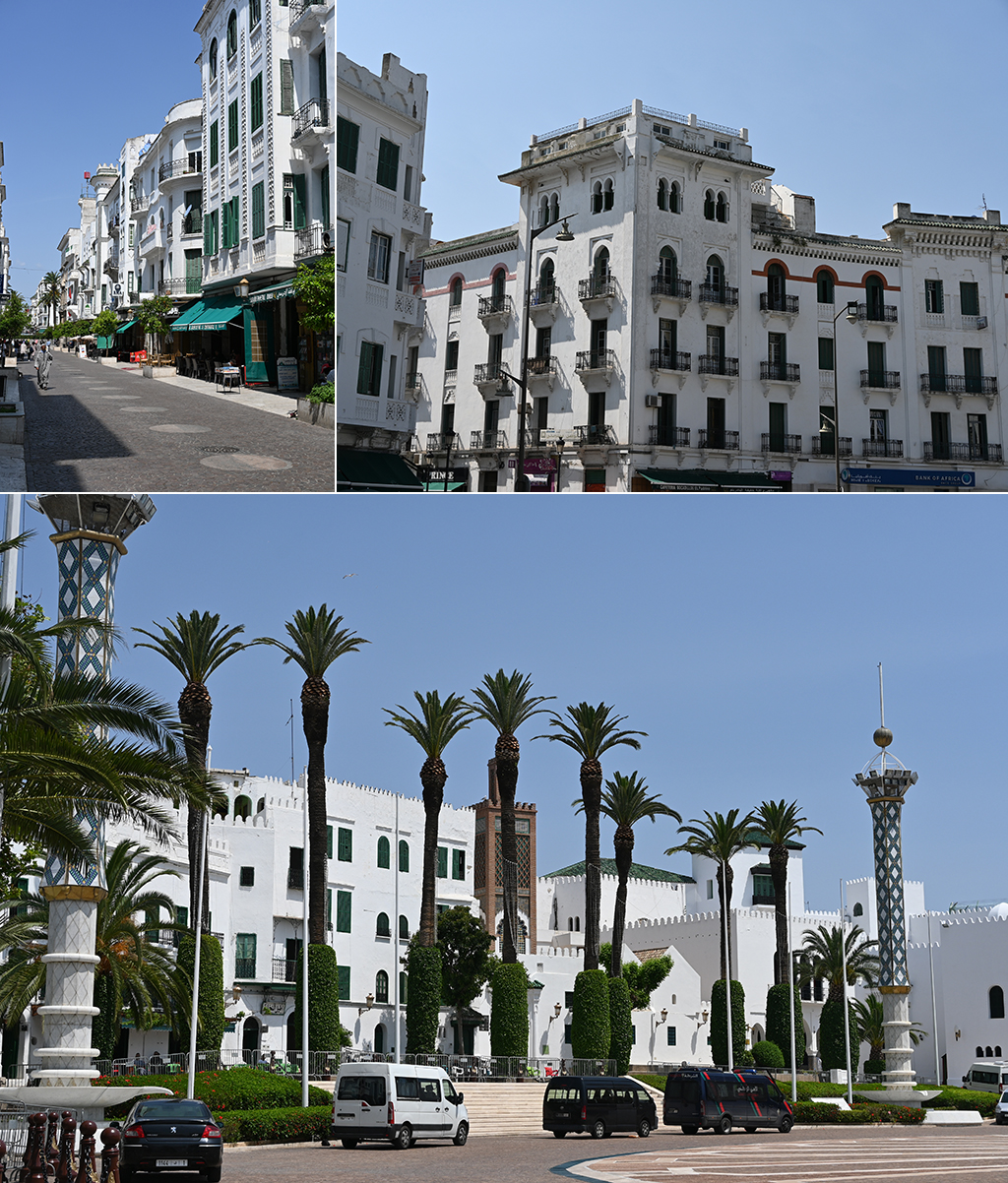
The next day we left Chefchaouen and drove for about a hour and one half for a quick tour of Tétouan before heading to our final destination of Tangier.
“The White Dove” — the nickname given to Tétouan — is predominantly painted bright white in contrast to the blue of Chefchaouen; it is Berber for “the eyes.” Like many Moroccan cities, it has a complex history. In terms of architecture, modern day Tétouan, which borders the medina, is visibly early-to-mid 20th century Spanish, because the city became the capital of Spanish Morocco in 1923 (until 1956 when it was returned to Morocco). Although Arabic is the dominant language, Spanish is more regularly spoken here as a secondary language unlike the French of the more southerly cities we visited.
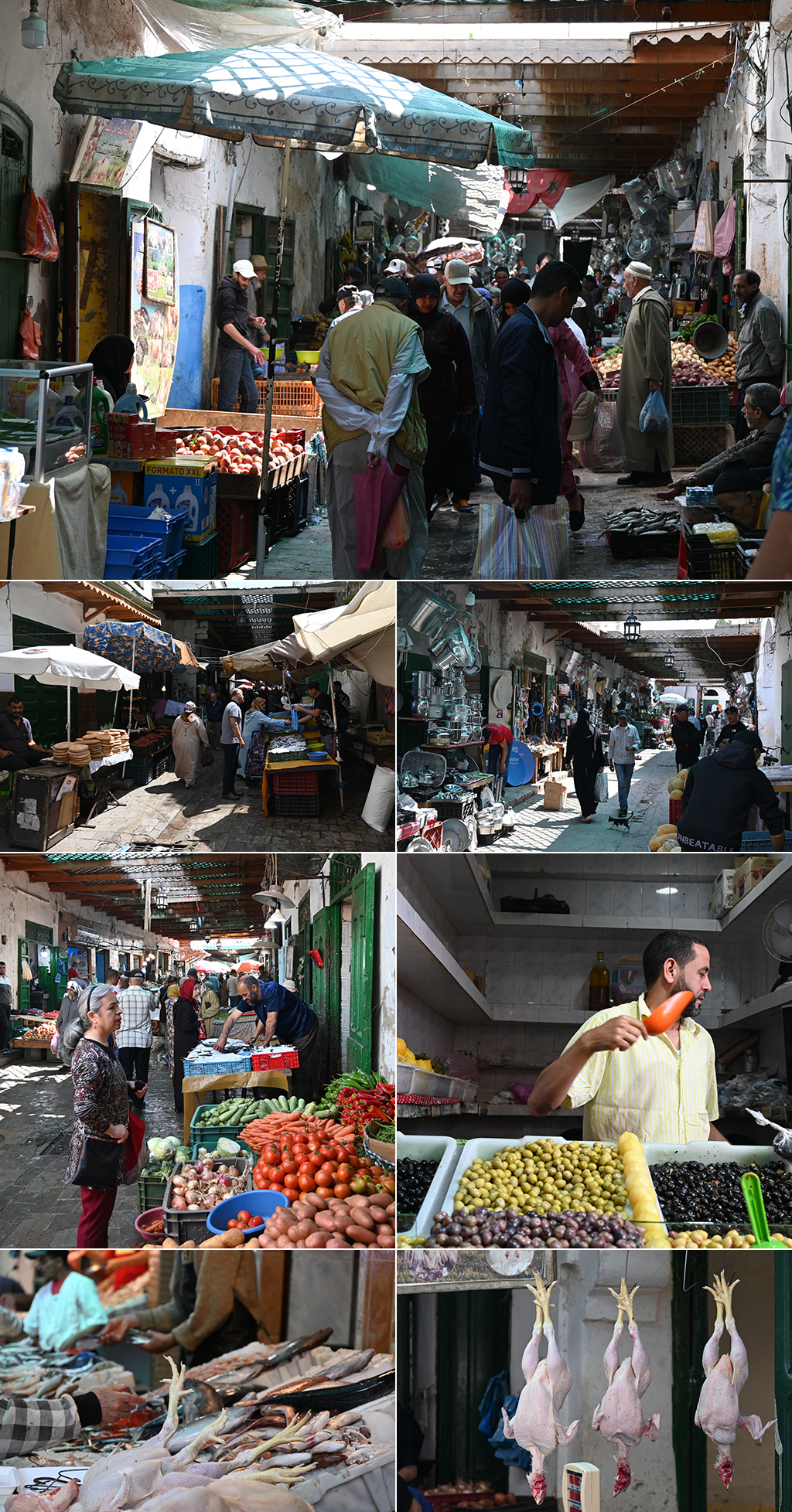
In the medina, you feel you’ve travelled back many centuries. Our first glimpses were of its lively market. Fruits, vegetables, nuts, chickens, clothes, kitchen equipment — it’s all there. Our guide, Abdul, stopped at one vendor and bought us mint and parsley to take to Tangier for Lisa’s kitchen. Some vendors worked in shops, and some had their wares in the street. Much of the market was roofed with lattice. It was jumping with people, including shoppers and delivery carts, but there were very few tourists.
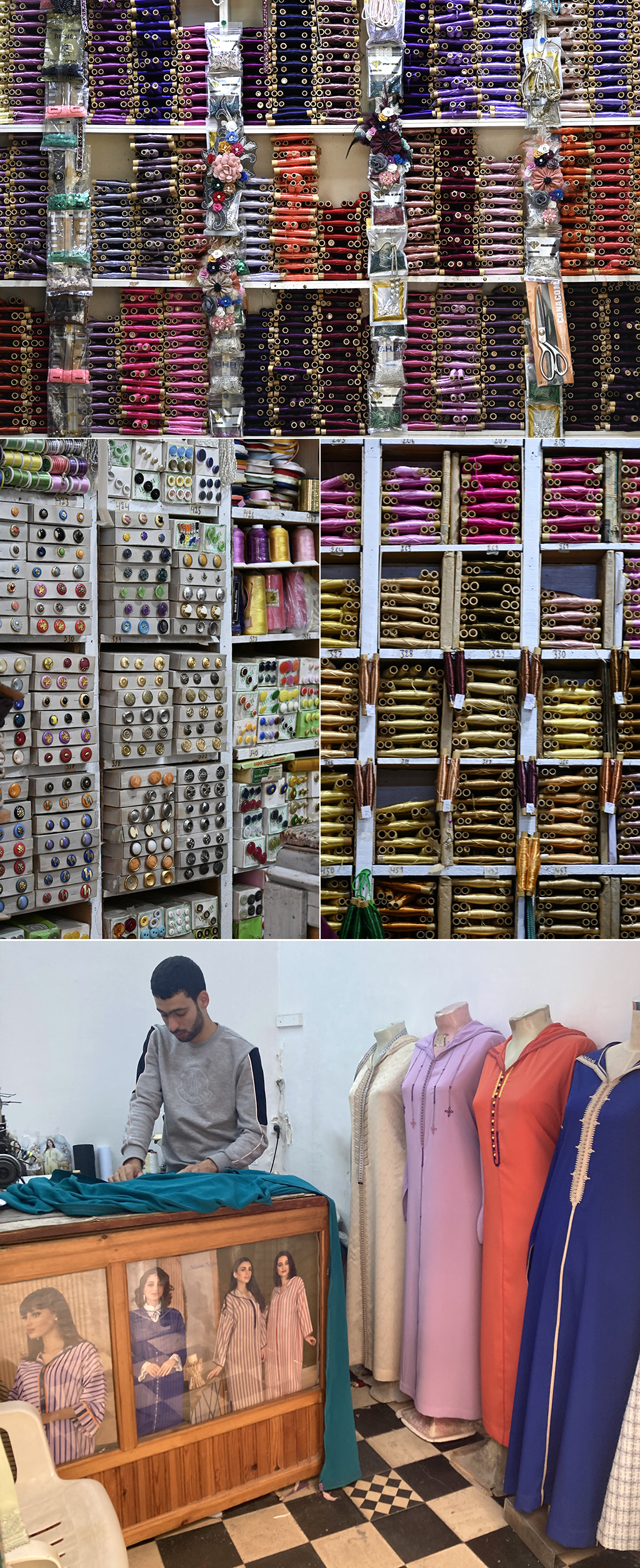
We walked through an area of tailors and makers of djellabas. I loved the colorful fabrics, threads and buttons. We continued through the streets, stopping to learn about such things as water distribution to each home, and that it is free.

Then, following Abdul’s lead, we plunged into the “new” Jewish Medina (mellah) for a little bit, and he showed us a gate on a house that was marked with the date of construction in both the Christian Jewish calendars (1899 | 5660), which are several thousand years apart in their start date.

As we learned elsewhere, the Jewish population surged with the advent of the Spanish inquisition. Centuries later, with the creation of Israel in the 1940s, Moroccan Jews moved there in increasing numbers, diminishing their local population. This mellah is now a Muslim neighborhood. It is full of twists and turns and angles and shops, and we saw a fountain with a Hebrew inscription. We went to the door of the historic synagogue, but it was closed for the day.
Lunch

In the medina, we dined in the Riad Restaurant El Reducto (Rue Zaouia, 93000 Tétouan), yet another hidden urban house built around a beautiful courtyard. The fare was simple and good. Being coastal, the menu featured seafood. I had fried baby sole with frites, and Mark had a large bowl of calamari.
Soon thereafter, we were back in the van en route to Tangier.

Again, The tour for the six of us friends was set up and administered by Medina Travel — Mr. Kamal Oujaâ — kamalmedinatravel@gmail.com.
If you need a official, licensed guide in Fès, ours — Said Abali — was excellent. He offers tours in French and English. He can be reached at saidtours69@gmail.com.
Things to note (this will repeated with each post):
Developed and maintained by Inspiratech LLC.
Design by Themeshift.
Susan Aceto
July 19, 2023 at 11:40 amI am loving your photos. And am SO glad I am on your distribution list!
Susan
Cocoa & Lavender
July 21, 2023 at 2:44 pmAnd I am so glad that you are loving all of this, Susan. It’s really fun for me.
Mimi Rippee
July 19, 2023 at 2:16 pmOh my goodness. I can’t get to Morocco fast enough! That blue!!! Those beautiful people. The colors in the markets. I love it all. Such beautiful photos.
Cocoa & Lavender
July 21, 2023 at 2:44 pmThat’s exactly the way I felt, Mimi! I can’t wait to go back.
Mad Dog
July 19, 2023 at 3:48 pmMore fabulous photographs and the blue is quite a contrast to the similar white streets in Andalucia.
Cocoa & Lavender
July 21, 2023 at 2:44 pmI know there’s a lot of blue throughout Morocco, but this concentration of it is stunning. Thanks, Mad Dog.
Eha
July 19, 2023 at 4:15 pmThis fascinating journey belongs in a book – so beautifully and logically capered and displayed – going back for a slow, slow second look!
Cocoa & Lavender
July 21, 2023 at 2:43 pmThank you so much, Eha. I really enjoyed putting this one together especially.
Lisa Harper
July 20, 2023 at 5:29 amI agree with EHA. Your Moroccan travelogue belongs in a book because of its superb photos and flawless text. Bravo! Your eye picked up details of daily life that other “tourists” miss.
Cocoa & Lavender
July 21, 2023 at 2:42 pmYou are so kind, Lisa! We are so grateful that we had your knowledge to get us where we need to go so that I could take these wonderful photos.
Carolyne
July 21, 2023 at 12:40 pmWow another fabulous post. The range of blues in Chefchaouen is simply amazing. And, as always your photos capture the feel of each place. Bravo !
Cocoa & Lavender
July 21, 2023 at 2:41 pmThank you so much, Carolyne! I specifically wanted to go there for the beautiful blue colors, and I was not disappointed.
sherry (from sherry's pickings)
July 21, 2023 at 11:09 pmI find this almost overwhelming David. So much beauty and delight here. The architecture, the magnificent tile work, the food, the people – all so beautiful and amazing. what a trip you had!
Cocoa & Lavender
August 17, 2023 at 12:07 pmMy eyes had such a time adjusting to all the blue, Sherry! But it was gorgeous!
Velva
July 23, 2023 at 9:17 amDavid, this was a wonderful post about your travel to Morocco. I enjoyed the photos, the architecture. You shared a very important tip about respecting the culture and not assuming because we often snap photos without permission, and wear shorts and tee shirts on a hot day, it is not always respectful as a guest in a different country. We should make a point of learning the basic customs and respecting them.
Thanks for this wonderful post!
Velva
Cocoa & Lavender
August 17, 2023 at 12:09 pmThanks, Velva. I appreciate that — and we do try to be so respectful when we travel. I first became aware of this when I was in Chenonceau many years ago and at he next table, there were four Americans being so loud, as if no one else were there. It really made me realize I need to keep my voice down… and I am a pretty loud guy. (Just ask Markipedia!)
Frank | Memorie di Angelina
July 25, 2023 at 5:50 amAnother series of gorgeous photos. You really do have an exquisite eye.
You touch on a really important topic of tourism. As you say it can be a good thing, up to a point. But it can also ruin a place if it’s left unchecked—for the inhabitants and also, ironically, for the tourists. I saw that when I was in Rome this spring. But it’s hard to know what to do. I’m hoping that the current craziness is just a phase as people make up for lost time during the pandemic things will eventually return to “normal”, whatever that is.
But then again, as you say, *we* are tourists, too. so complaining about there being so many other tourists does seem a bit… ironic. Anyway, it seems that Morocco isn’t anywhere near that point. I’m seeing a place that very much still has its own charming character!
Cocoa & Lavender
August 17, 2023 at 12:11 pmMark and I were discussing the difference between being a tourist and being a traveler. We prefer to think of ourselves as the latter. A lot of it is about attitude, isn’t it?
Supraja Lakshmi N
July 27, 2023 at 11:15 pmI find Chefchaouen to be a very fascinating and beautiful city. I love how it is painted in different shades of blue, which create a soothing and harmonious atmosphere. I would love to walk around its narrow streets, visit its mosques and markets, and admire its views of the mountains. I also find Tetouan to be a very interesting and diverse city. I like how it has a different vibe and architecture from Chefchaouen.
Cocoa & Lavender
August 17, 2023 at 12:12 pmThank you Supraja. Yes, it is fascinating how different two cities so closes can be. But I loved both, and am glad you enjoyed the tour.
Valentina
July 29, 2023 at 9:31 pmChefchaouen and all of the blue is incredible, the variations of it — overwhelmingly beautiful!
Cocoa & Lavender
August 17, 2023 at 12:12 pmSo many blues. So beautiful. Thanks for enjoying it!
Raymund
July 30, 2023 at 4:44 pmI’m looking forward to reading the final installment of your series on Morocco, which promises to be equally captivating and insightful. Thank you for sharing these beautiful travel experiences!
Cocoa & Lavender
August 17, 2023 at 12:13 pmThanks, Raymund!
Christina Conte
July 31, 2023 at 5:29 pmSimply etherial! A photographer’s dream, and you captured so many beauties! Thanks for sharing, David! Definitely an inspiration!
Cocoa & Lavender
August 17, 2023 at 12:13 pmThe blue is rather ethereal, Isn’t it? Thanks Christina – I am glad you enjoyed the tour!
Reliable Delivery from Tetouan to Chefchaouen
January 4, 2025 at 8:12 am[…] restaurant delivery service offers convenience, affordability, and top-notch customer service4. You get real-time tracking, secure payment options, and a guarantee of satisfaction. It’s […]